

 The South African
The South African
by C.J. BARNARD
EDITOR'S NOTE: REDAKTEURSAANTEKENING:
Professor C. J. Barnard was educated at Stellenbosch and London
Universities and at the University of South Africa. He is a former Chief
Narrator (Land Forces) of the War Histories Section of the Prime Minister's
Department (1950-1958) and Cultural Attache at South Africa House, London
(1959-1961), and has been lecturing in history at the University of South
Africa since 1962.
This article is a transcription of a talk by Professor Barnard to the S.A. Military History Society. A detailed account, fully documented, of General Botha's role in this battle is contained in Professor Barnard's book Generaal Louis Botha op die Natalse Front, 1899-1900, to be published shortly by A.A. Balkema.
At Colenso General Louis Botha was aged 37, by far the youngest general in the Boer forces. Only a few weeks previously he had risen from a common burgher to a general in one jump, and that in the course of a battle. During the battle of Modderspruit at Ladysmith, on 30th October, 1899, his commanding officer and colleague in the Transvaal Volksraad, General Lucas Meyer, collapsed and Botha calmly assumed command. The 2 000 burghers in his sector were at that stage engaged with an infantry and a cavalry brigade. But such were Botha's powers of leadership and instinctive grasp of the tactical situation that he soon drove his adversaries from their positions back into Ladysmith. The commander of the cavalry brigade was the future Field Marshal Lord French. His chief of staff was Major Haig, the future Field Marshal Lord Haig.
After the victories at Modderspruit, and at Nicholson's Nek the same day, Ladysmith was invested, and Botha was put in command of a reconnaissance in force into southern Natal, which was also accompanied by Commandant-General Piet Joubert. During the expedition Botha laid the ambush for the armoured train in which Winston Churchill was captured and fought a successful action at Brynbella Hill near Estcourt. Then General Joubert, who was 68, was seriously injured when his horse stumbled under him and Botha's men withdrew to the north bank of the Tugela River at Colenso. On 30th November, Joubert returned to his farm at Volksrust to recuperate and Botha was left in command of the Tugela line to face the British Army which was to attempt to relieve Ladysmith.
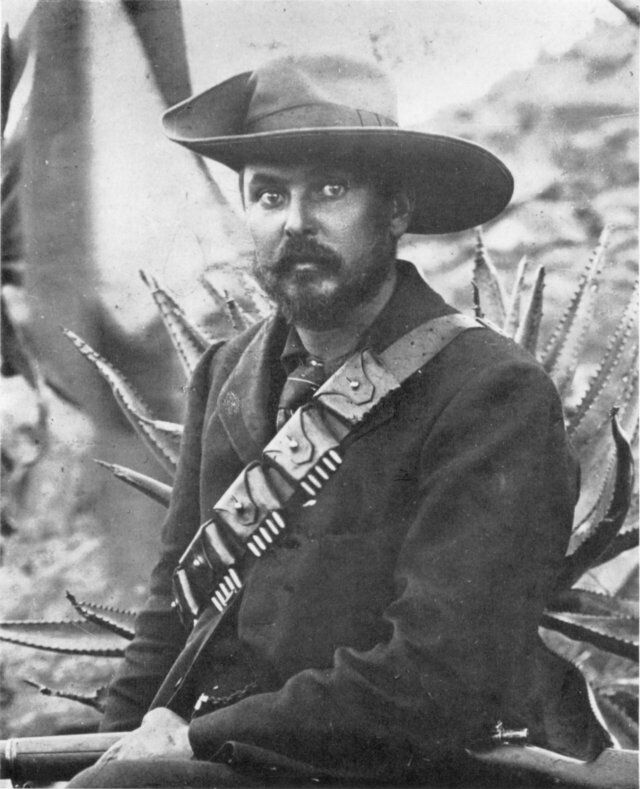
General Louis Botha at Colenso, Dec. 1899
Before Joubert's departure the defence of the line was discussed in a krygsraad, a council of war of officers. At the meeting Botha persuaded his officers - most of whom were his seniors in age and had until recently also been his seniors in rank - that they should dig in as closely as possible to the river. A proposal that they should take up position in the higher range of hills a few miles further back - from Red Hill to Pieter's Heights - was rejected. Botha's purpose was, first, to achieve the greatest measure of surprise, and secondly, to use the natural obstacle of the Tugela as his first line of defence - which he would otherwise have had to abandon without a fight.
Botha was convinced that the British with their huge ammunition and supply columns would remain near the railway and would attempt to cross the river in the vicinity of Colenso. He decided therefore to entrench along a seven-mile front from Hlangwane Hill to the slopes of Red Hill. Viewed from the south, the low hills along this front - except Hlangwane, which is a prominent feature - are hardly visible against the high rampart of hills to the north. Yet they afford excellent observation and an unrestricted field of fire over the plain stretching out before them.
On the day of the battle (15th December, 1899) Botha had at his disposal 4 500 men, of whom, as he pointed out in his official report of the action (see below), less than 3 000 were actually engaged. His artillery consisted of four guns and a pom-pom, a 120 mm Krupp howitzer, a 75 mm Krupp field gun and a pom-pom in the Colenso Koppies, a 75 mm Creusot field gun on Red Hill and another Creusot 75 on Cannon Koppie.
During the period of digging in Botha insisted on stringent security measures. Defence works and gun emplacements were carefully camouflaged. Trenches were skilfully sited in the tall grass along the flats and the soil dug up was strewn around so as to leave no visible mound. Liberal use was made of dummies, and in the dummy gun-emplacements gun barrels of corrugated iron were pointed menacingly to the south. Two-thirds of every commando had to man the defences at night, one-third during the day. No lights had to be seen at night - smoking was strictly prohibited - and scouts were out on the plain, day and night, to watch and report on the enemy's movements.
Over all these activities Botha maintained a close personal supervision. He regularly visited the front to see for himself that his orders were being carried out and to encourage his officers and men in the lines. Reuter's war correspondent with the Boers, Jimmy Roos, a young Pretoria attorney and later Secretary for Justice and Auditor-General of South Africa, described the scene at Botha's headquarters during these days as follows:
"General Louis Botha's tent at Colenso was an ordinary bell affair captured at Dundee. In this there was a convertible stretcher and chair, generally occupied by the General. In front of this was a packing case serving as a table ... Botha being a young man with becoming reverence for age, always rises when a white-bearded burgher enters and gives him the stretcher chair, while he literally sits at his feet on the ground ... Burghers drop into the tent all day long to hear the news or bring reports. The General has no private life. He eats, drinks and sleeps before a coming and going procession. Reports are received and dispatches dictated in the presence of a dozen chance visitors ...."
Botha endured these inconveniences because he could not afford to estrange even a single burgher, and he gained his reward in the esteem and affection of his men.
From the start Botha's plan was to allow the British during their attack to approach well within rifle range. There was to be no response to the usual heavy artillery preparations. During the actual assault the burghers and gunners were to hold their fire until he himself gave the signal with a shot from the big howitzer. But Botha did not contemplate a purely defensive action. When the enemy had become fully engaged on his front, the Boksburg and Soutpansberg field-cornetcies on Hlangwane Hill (650 men in all) were to counter-attack from the left. Simultaneously a composite force of Johannesburgers, Middelburgers and Free Staters on a spur of Red Hill (1 500 men in all) was to cross the river and attack from the right.
Despite all his careful preparations, however, Botha's position tactically was not a strong one. The weakest link and true key to it was Hlangwane Hill, held by only 650 jittery volunteers, and extremely vulnerable because of its isolation on the opposite bank of the river. Once the British established themselves on this hill the rest of Botha's positions could be enfiladed by artillery and rendered untenable.
Fortunately for Botha, his opponent, General Sir Redvers Buller, did not realize it. Nor did he attempt by intensive reconnaissance to learn more about the force and the terrain with which he was confronted. The army which he had assembled at Chieveley was indeed impressive: four infantry brigades, a mounted brigade, two 4.7-inch and 12 twelve-pounder naval guns and five batteries of field artillery - altogether approximately 20 000 officers and men with 44 guns. There was every reason for his confidence that he would be in Ladysmith before Christmas.
On 13th December, 1899, Buller opened his bombardment. The next afternoon he called together an order group of senior officers to explain to them his plan of attack. The assault was to start the next morning at daybreak. The main object of attack was to be the Colenso Koppies. These were to be attacked frontally by General Hildyard's 2nd Brigade. On the left General Hart's 5th (or Irish) Brigade was to cross the river by a ford "immediately west" of the confluence of the Doringkop Spruit with the Tugela and push down along the north bank towards the Colenso Koppies.
The sketch map which General Hart received with his instructions (see sketch) confirmed Buller's ignorance of the area. It showed erroneously the Doringkop Spruit joining the Tugela west of the great loop - and this caused confusion about the location of the ford when the error was discovered during the advance the next morning.(1) Moreover, there was no question of Hart's brigade being able to cross the river more or less without opposition and advancing towards Colenso. Like Hildyard, he would immediately become involved in a frontal attack against an entrenched enemy, who would also outflank him on the left.
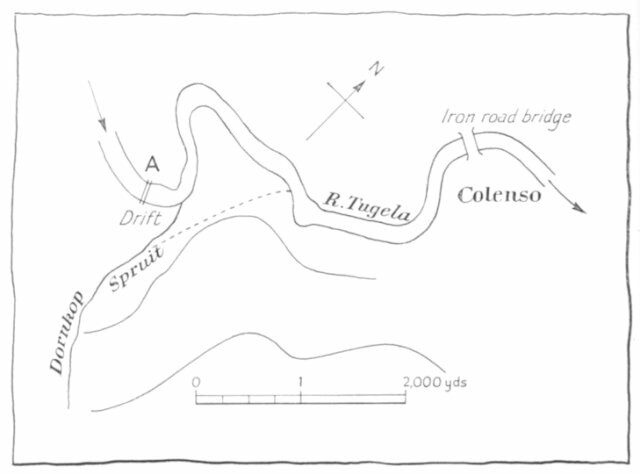
Course of Tugela and Doringkop Spruit as indicated on Gen. Hart's sketch
(actual direction of spruit shown in dotted line)
On the right Lord Dundonald's mounted brigade was to carry out only a minor manoeuvre towards the vital position of Hlangwane Hill, where, according to Buller's orders, Dundonald's men were to "endeavour" to establish themselves. But essentially it was a move only to protect the flank of Hildyard's frontal assault. The other two brigades - General Lyttelton's 4th (or Light) Brigade and General Barton's 6th Brigade - were to be held in reserve on Hildyard's left and right, ready to support either the centre or the flanks; and the whole operation was to receive very heavy artillery support.
Buller's plan of attack resembled the wild swings of a blindfolded pugilist in the general direction of his opponent. Of the river in front of him and the burghers who guarded it, he had only the vaguest notion, and he did not realize the decisive tactical significance of Hlangwane Hill. When Lord Roberts visited the battlefield after the war, he described Buller's attack as "sheer murder", and an officer who attended Buller's briefing, afterwards commented ruefully: "And may the Lord have mercy on our souls."
Yet, if General Buller had only known, he could have broken through Botha's front that day (14th December) without much difficulty. Although Buller's bombardment on 13th December had caused no casualties and had confirmed Botha's belief that he would attack at Colenso, the Soutpansberg field-cornet on Hlangwane (Briel) panicked during the night and evacuated the hill with most of his men. Botha was disgusted. But he could not deal with this officer as no doubt be wanted to; nor could he order another unit to reoccupy the position. According to Boer custom, a krygsraad had to be convened, which meant that Botha's whole plan would be subjected once again to the mercy of a debating society.
Faced with the imminent collapse of his line even before the attack, Botha now committed his only error of judgement at Colenso. He called upon the Acting Commandant-General, Schalk Burger, to come over from Ladysmith and assist him. Fortunately for the Boers and for Botha personally, the indifferent General Burger refused. The next day, however, he raised an elderly Middelburg burgher, Christian Fourie, to the rank of general and sent him to Colenso as Botha's "assistant". Botha thereupon all too rashly placed Fourie in command of his right flank - an arrangement which he was later to regret bitterly.
At the krygsraad, meanwhile, the debate on Botha's scheme of defence was reopened. Many officers advocated a complete and immediate withdrawal to the Red Hill-Pieter's Heights range. Despite Botha's opposition, a decision was taken to abandon Hlangwane. Botha was determined not to accept this decision, which would obviously wreck all his plans. He ordered the krygsraad to meet again the next morning (14th December) and in the meantime recalled the Boksburg field-cornet (Dercksen) who still held Hlangwane and in whom he now had as little faith as in his Soutpansberg comrade. After observing the despondency of so many of his officers, Botha spent the rest of the night visiting all sectors of the front.
Early the next morning help arrived from President Kruger (who had been kept informed of all developments at the front). In a lengthy and characteristic telegram to his officers the President ordered them to hold on to their posts dead or alive. The surrender of vital positions could only lead to the surrender of the Republic itself and then - the President asked - "where would you go then ?"(2) In another message he added typically: "Fight in the name of the Lord and you will be convinced of God's guidance, and will be victorious."(3)
The whole area was under shell-fire when the krygsraad met again. Armed with President Kruger's telegrams, which he read to his officers, Botha succeeded in persuading them to return to their positions and reoccupy Hlangwane Hill. At his suggestion the detachment which was to hold Hlangwane, was assigned by the drawing of lots - 800 to 1 000 men of various commandos under the brave old Wakkerstroom commandant, Jozua Joubert. And by the evening Botha's front was once again intact. The only adjustment to his plans was that, in view of the disquiet in his ranks about Hlangwane, Jozua Joubert was sent there in a defensive role. The counter-attack was now to be solely a right hook.
That night Botha slept on the sandbagged parapet of the howitzer in the Colenso Koppies. About one o'clock the next morning - Friday, 15th December - he heard one of the gunners asking a friend:
"Do you see all those lights over there at Chieveley?"
Botha rose immediately. Across the plain the whole British camp was alight, and he realized that the long-awaited attack was at hand. The news spread quickly along the Boer positions and the burghers made their final preparations in silence in the remaining hours of darkness. At daybreak an extraordinary spectacle unfolded before them. "On a front two miles wide and a mile deep, line upon line of helmeted men" moved across the veld in a pall of dust.
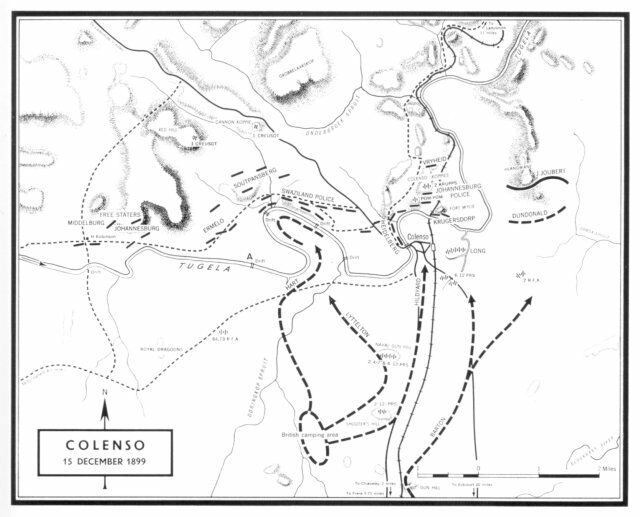
At 5.20 the naval guns opened the battle with a tremendous bombardment. Watching the advance from the howitzer gun pit, Botha observed to his astonishment that the leading troops approaching the Colenso Koppies were not infantry, but a detachment of artillery. By 6 o'clock Colonel Long, Buller's artillery commander, who personally accompanied the guns, had brought the two leading field batteries to within 1 300 yards of the Krugersdorp trenches, with the nearest infantry more than a mile further back. Botha would undoubtedly have preferred to reserve his fire until the infantry, too, were well within rifle range. He had, in fact, hoped to allow at least some of them to cross the Colenso road bridge. But when the guns began to unlimber, he could wait no longer.
The howitzer then boomed its signal. From the Colenso Koppies there followed an immediate crash of musketry, to which the Krupp guns and the pom-pom added their contribution. Within half an hour all 12 Armstrong guns had been silenced and the surviving gunners had taken refuge in a donga some distance to the rear. British historians have suggested subsequently that the guns only ceased firing when their ammunition was exhausted. After the battle, however, the Boers collected 12 ammunition wagons with 1 300 rounds and six of the deserted guns were loaded.
On the Boer right, too, there had been extraordinary developments. General Hart, who was to cross the river in this sector, marched his brigade in mass of quarter columns over the open veld, the Royal Dublin Fusiliers leading, followed by the Connaught Rangers, the Borders and the Inniskilling Fusiliers. When Hart reached the Doringkop Spruit, flowing to the north-east, he realized that Buller's sketch map was inaccurate. After crossing the spruit he observed to his annoyance that the native guide was continually pointing up the loop in the river. After a consultation the guide explained through an interpreter that the only ford in the area was at the top of the loop.(4) Since his sketch map had already proved inaccurate in one respect, General Hart allowed himself to be persuaded that it was also inaccurate about the fords. And into the loop he rode at the head of his men.
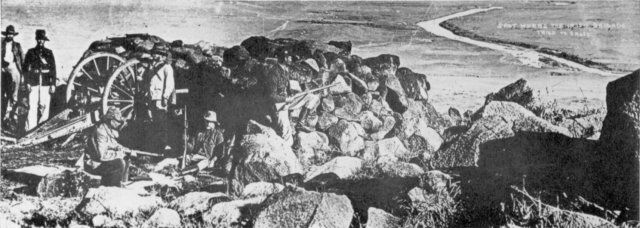
Boer 75mm Creusot Field gun overlooking loop in Tugela
At this stage the Creusot guns opened fire, followed by the riflemen around the loop. Already the third shell ploughed into the tightly packed ranks of the Connaught Rangers. As the men loosened out, units became inextricably mixed and General Hart was no longer in complete control of his brigade. Groups of men followed officers up the loop without any clear idea of where they were going or what was happening. Others simply threw themselves on the ground in the tall grass and remained where they were.
After about an hour General Buller, who had been watching the Irishmen putting their heads into the noose, decided to break off this attack. To General Lyttelton, commander of the reserve brigade in this area, he said: "Hart has got into a devil of a mess down there. Get him out of it as best you can." In the confusion in the loop, swept as it was by heavy fire, it was no easy task to extricate the battalions and the withdrawal was not completed until well in the afternoon, the Irishmen having suffered some 550 casualties.
The counter-attack which Botha had ordered here, did not materialize. With the Irish Brigade entrapped in the loop a heaven-sent opportunity had arrived for the Johannesburgers, Middelburgers and Free Staters to carry out a really effective counter-stroke. But to Botha's intense annoyance nothing happened. Three times he sent messengers to Christian Fourie, whom he had so unwisely put in command of this sector only 24 hours before, urging him to deliver the attack; but Fourie was not up to his task. He withdrew the Johannesburgers to reinforce the Ermelo commando, which was under no pressure whatsoever, and ordered the Middelburgers and Free Staters to remain on the hill. When Botha sent a message to the Free State commander, General Andries Cronjé, demanding an explanation of why he did not carry out his orders, Cronjé replied: "Hier het 'n nuwe generaal uit die lug geval en ander bevele gegee." Botha was furious, but there was nothing he could do. After the fight he remarked in a private telegram (to General Lucas Meyer in Pretoria): "Had the Middelburg and Free State commandos carried out my instruction and crossed the Tugela, we would have taken a thousand prisoners and probably six more guns. Instead they continued to watch the battle, sitting manfully on the mountain."(5)
With his batteries silenced in the centre and his left attack checked so early in the fight, General Buller thought only of abandoning the attempt and withdrawing from the battlefield. Riding forward with his staff towards the deserted guns, he found General Hildyard who was still hanging back out of rifle range with his brigade which was to have attacked in the centre. Buller told Hildyard that the original plan was off, that Long's batteries had got into a terrible mess and that he should push forward two battalions to cover the retirement of the guns. As the troops advanced in open order under a renewed barrage of the naval guns, the Boer fire increased as well, and into this cauldron Buller rode with members of his staff. Before arriving at the first donga behind the guns, he was injured by a shell burst, which killed his staff surgeon beside him.
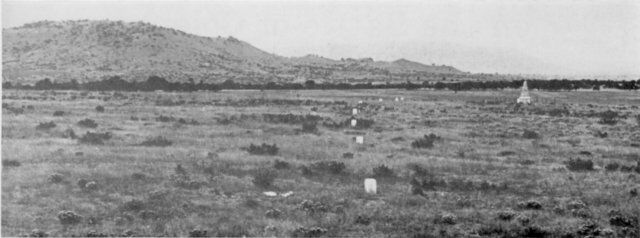
Positions of Long's guns marked on Colenso battlefield.Hlangwane Hill in background.
Although severely bruised Buller remained silent about his injury. In the donga he ordered that an attempt be made to bring back the guns. Volunteers were called for, a few limber teams were prepared, but the men and horses were mown down as they dashed towards the guns. Two of the 12 pieces were nevertheless limbered up and brought to safety. It was during this gallant but foolhardy attempt that Lieutenant Roberts, the only son of Field Marshal Lord Roberts, was mortally wounded. He was posthumously awarded the Victoria Cross, as were two of his fellow-officers who carried him back to the donga and four others - seven V.C.'s in all for this attempt. Later Lieutenant Roberts was brought to the field hospital by Indian stretcher-bearers who were serving at Colenso under the leadership of the young Durban advocate Mohandas Gandhi, later to become the leader of his people.
After watching the disastrous failure of the efforts to save the guns Buller, probably overcome by panic and remorse, ordered their abandonment and the withdrawal of the entire army. Meanwhile Dundonald's mounted brigade had also been fought to a standstill. The regiments were at this stage pinned to the ground at the foot of Hlangwane. Dundonald's officers included two future field marshals and army commanders in France during the First World War -- Field Marshal Lord Byng, then commander of the South African Light Horse, and Field Marshal Lord Birdwood, then a captain on Dundonald's staff. Among the Boers wounded at Hlangwane was old Jozua Joubert, hit by a shell-splinter above the knee. During the hottest fire he had walked about from point to point, encouraging his men and cracking jokes.
According to General Lyttelton the battle of Colenso was one of the most unfortunate in which the British Army had ever been engaged, and in none, he said, had there been such a deplorable tactical display -- "no proper reconnoitring of the ground, no certain information as to any ford by which to cross the river, no proper artillery preparation, no satisfactory targets for the artillery, no realization of the importance of Hlangwane." And another British officer wrote: "We all hammered our heads against a stone wall about which none of us knew anything."
By 2.30 in the afternoon the fight was over. The naval guns were still firing when Botha's brother-in-law, the future General Cherrie Emmett, crossed the river with a detachment of his Vryheid burghers and other volunteers to collect the 10 abandoned field guns. They also took some 150 prisoners who had been left behind in the donga in rear of the guns during the retreat. At 7.46 that evening Botha telegraphed the following despatch to President Kruger:
"The Lord of our fathers has today given us a brilliant victory. We have repulsed the enemy on all sides, at three different points. We allowed them, under a violent bombardment from their side, to advance 12 guns up to a point very near the river. As soon as these had been unlimbered, we opened fire with our Mausers, killing the gunners and disorganizing them to such an extent that they only succeeded in recovering two of the guns. We took the other 10 -- big beautiful cannons -- together with 13 [actually 12] full ammunition wagons. About 150 of their best men, those who stormed so bravely time after time, were taken prisoner. Among them are several officers. The enemy's losses must have been terrible. They are lying one on another - I think possibly 2 000 men. We have about 30 killed and wounded. I shall later send you exact reports. With a thankful heart I can congratulate you and the Afrikaner people on this brilliant victory ... Guns already brought through the river, and I respectfully request the Government to proclaim a general day of prayer to thank Him who gave us this victory."(6)
Botha's request was granted. The next Sunday was observed as a day of prayer throughout the Republic.
General Buller, at his own request, was granted a 24-hour armistice to bury his dead. There is no doubt that Botha, despite his youth and inexperience, outclassed General Buller as a commander in this battle. The test of generalship has always been the test of adversity, the ability to do much with little. At Colenso, Botha defeated an army of 20 000 men and 44 guns with less than 3 000 men and five guns (including the pom-pom). In doing so, his application of the age-old principles of war, security and surprise, could hardly have been bettered. His casualties were only 38, of whom only eight were killed. The British losses were officially given as 1 139, of whom seven officers and 136 men were killed and some 250 were missing. Botha, however, always maintained his original estimate of enemy casualties, namely 2 000. This figure was in no way exaggerated, he telegraphed Pretoria after crossing the Tugela the next afternoon and seeing the remaining enemy dead on the battlefield. He could not bring himself to have the bodies counted, he said, because he felt that would be too callous.
The news of Buller's defeat in the same week as the equally disastrous defeats at Stormberg and Magersfontein caused consternation in England. The British Cabinet was particularly dismayed by Buller's message to General White in the beleaguered Ladysmith that he should burn his ciphers, shoot away his ammunition and get the best possible terms from the Boers. On 17th December, Buller was superseded as Commander-in-Chief, South Africa, by Lord Roberts, with Lord Kitchener as his chief of staff. On this day, too, Roberts received the news of the death of his son. In October, 1901, Buller's message to White led directly to his discharge from the British Army.
Botha, on the other hand, emerged from the battle the hero of his men. The victory had spread his fame across the world. Previously a relatively unknown officer and member of the Volksraad, he had become overnight a national figure and a leader of his people. This he was to remain for the rest of his life. Colenso was therefore the first important rung in the ladder that was to carry him only 10 years later to the top of his country's affairs.
Return to Journal Index OR Society's Home page
South African Military History Society / scribe@samilitaryhistory.org